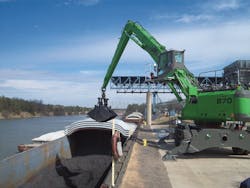Material Handler Reduces Offloading Times
Kinder Morgan Terminals recently invested in a Sennebogen 870 M material handling excavator to reduce offloading times from cargo barges at its Amory, Miss., terminal. The terminal operates one continuous dock where it handles commodities such as bulk ores, steel, lumber and rock coming from cargo barges in the Tenn-Tom Waterway, a 234-mile artificial waterway that provides a connecting link between the Tennessee and Tombigbee Rivers.
Kinder Morgan is one of the largest pipeline transportation and energy storage companies in North America with more than 37,000 miles of pipelines and 170 terminals. The company transports, stores and handles energy products including natural gas, refined petroleum products, crude oil, ethanol, coal and carbon dioxide. Its equipment fleet helps meet demands from shippers for quick, efficient transfer of commodities.
Terminal manager Jim Strawn says that the hydraulic elevating cab on the 870 M gives his crew the ability to see as they reach into the barges; but more importantly, it has a purpose-built undercarriage with rubber tires. "Mobility is the key for us and since this unit is on rubber tires, we can move it a lot easier," Strawn says. Special outrigger pads reduce the ground pressure of the machine and protect the dock surface.
Kinder Morgan purchased the 870 M with a 6-yard clamshell bucket and a generator package.
"In the future, we are looking at doing a few more things with it like attach a magnet and grapple to give us a little more versatility," says Strawn. "There are several different markets out there we hope to get into, and this machine gives us the option of doing that." The 870 M is primarily used for unloading coal, but it can be outfitted with another clamshell if the terminal gets a rock contract.
Prior to settling on the Sennebogen model, Strawn says that he looked at other machines.
"We visited the steel mills here and other terminals up the river from us like the Hickman Terminal, that run Sennebogen machines," he says. "They liked them, and I know the steel mills were keen on them."
Strawn says he was pleasantly surprised when they started to put the 870 M through its paces.
"I was looking for a machine that can offload a barge in six to six and a half hours," he says. "So far, if the conveyors are working all right, the Sennebogen unit can unload a 35x200-foot standard-size river barge in about four and half to five hours, just using the bucket and conveyor."
In addition to the time benefit, Strawn appreciates the visibility due to the machine's hydraulic elevating cab system that gives the operator a better top down view to see inside the barge.
"From an operator standpoint, the guys love that machine because it's stable and once they get set up they can see in the barge without having to strain themselves," says Strawn. "When it's up about 22 feet in the air, from that vantage point, the operator can almost see right into the corners. Most of the time they have it raised up about three-quarters of its extended cab position. That way the operator is further out and it is a lot easier for them. With the visibility we get from this machine and the rotating clamshell, we can clean the barge floor pretty good before running a skidsteer in there at the end for the final cleanup."
—Material supplied by Senneboge
